Seminar: Bacterial extracellular electron transfer toward sediment bioremediation
Yonggang Yang, Guangdong Institute of Microbiology, China
Info about event
Time
Location
Ny Munkegade 114, building 1540, room 116
Organizer

Abstract:
Bacterial extracellular electron transfer (EET) is an importance driving force for pollutant biodegradations and biogeochemical processes in sediments. Using Shewanella decolorationis as a model EET bacterium, we found that it could perform EET without cytochrome c when higher concentration of electron shuttle was provided. An outer membrane protein containing Fe-S cluster and a periplasm protein Mcc may participate in the alternative EET pathway. The presence of other electron donors did not decrease the EET by S. decolorationis biofilms on microbial fuel cell anodes, as the biofilms could form a stratified respiration pattern to reduce multiple electron acceptors simultaneously. In contaminated sediments, bacteria EET could enrich the microbes and functional genes involved in various electron transfer and degradation processes which could explain the fact that EET is useful in degrading different types of pollutant. On the other hand, compared to nitrate reduction, bacterial EET preferred to degrade organics with higher polarity. Our field-experiments showed that EET driven-microbial fuel cells have great potential to be applied as a long-term device for simultaneous sediment bioremediation and water monitoring.
